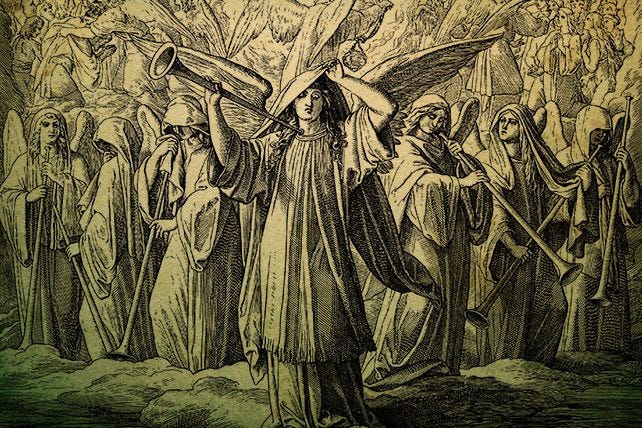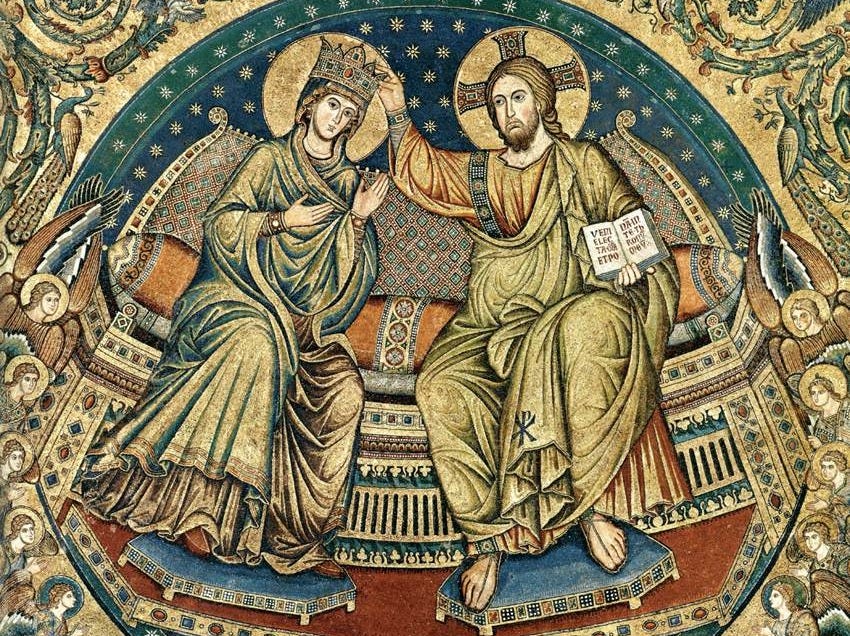Acts, Chronicles, Revelation, and the Assumption of Mary
Unveiling the biblical connection between the Ascension, Pentecost, and the Assumption
A few years ago I came across a graphic on a Catholic social media account that pointed out some interesting connections between Acts 1 and 2 Chronicles 5-7. The purpose of this graphic was clearly an apologetic one, meant to highlight our Lady as the new Ark of the Covenant. I’m usually skeptical of people who haphazardly make connections in Sacred Scripture for apologetic purposes (though I’ve certainly been guilty of doing this), and so I decided to investigate the matter for myself. To my great delight, I discovered that the connections between these passages of Scripture likely went deeper than the author of that graphic even knew.
The clearest points of contact between these two scriptures, which the original graphic highlighted, are the following:
2 Chronicles 5:2-12
120 priests
in the Temple
with the Ark of the Covenant
Acts 1:12-15
120 disciples
in the Upper Room
with the Virgin Mary
Although some might scoff at typological connections like this, I knew better than to dismiss these ones without consideration. As I’ve documented before,1 Acts 2:41 arguably makes a numerical allusion to Exodus 32:28 when speaking of the “three thousand” people who were baptized on Pentecost. St. Luke drawing another numerical connection therefore wouldn’t surprise me. Likewise, I’ve long been convinced that the beginning of St. Luke’s Gospel portrays the Blessed Virgin Mary as the Ark through a series of allusions to 2 Samuel 6.2 Mary being typologically associated with the Ark at the beginning of Acts thus fits well.
And there’s more. After this passage in 2 Chronicles, it’s King Solomon who says the prayer for the dedication of the Temple, wherein he explicates the Psalms of his father David (2 Chron 6:16-17, 40-42). This also corresponds well to the beginning of Acts, where it’s the Apostle Peter who “stands up among the brothers” to explain that “which the Holy Spirit spoke beforehand by the mouth of David” (Acts 1:15-16), something he continues to do in his sermon that announces the new covenant (Acts 2:14-36). After Solomon’s prayer was finished, fire came down from heaven to consume the priests’ sacrifices, and fill the Temple with the glory of God (2 Chron 7:1-3). This obviously corresponds to what happened after St. Peter’s first speech: the Holy Spirit descended in tongues of fire at Pentecost (Acts 2:1-3), which traditionally marks the beginning of God’s presence in the new Temple, the Church.
My biggest take away from this was about how these connections provide an interpretive key into how the New Testament authors themselves read Scripture. Consider the Psalm that Solomon quotes in 2 Chronicles 6:40-42,
Arise, O Lord, and go to your resting place, you and the Ark of your might…
Psalm 132:8
If the above mentioned connections are legitimate, then the book of Acts identifies Mary as the Ark of this Psalm, since Luke connects her to the Ark of 2 Chronicles 5-7 where Psalm 132 is literally enacted while it’s being prayed. This is significant because, in both the Byzantine and Latin liturgical traditions, Psalm 132 is chosen for the Feast of the Assumption (or Dormition) of the Blessed Virgin Mary. In other words, both the Greek East and the Latin West read David’s words, “Arise, O Lord, and go to your resting place, you and the Ark of your might,” as a prophetic reference to our Lady’s bodily Assumption into heaven. As such, if identifying Mary with the Ark of this Psalm truly does go back to the Apostle Luke, then this would seem to vindicate the apostolic origin of the Church’s Marian reading of this Psalm.3
Indeed, Pentecost would be a supremely fitting event for St. Luke to foreshadow our Lady’s Assumption. In order to see why, consider the fact that the book of Revelation provides us with a “heavens-eye view” of both Pentecost and the bodily Ascension of our Lord: in Revelation 4-5 when the Lamb is enthroned in heaven, the Ascension; and in Revelation 8:1-5 when Jesus takes “fire from the altar,” the Spirit, and casts it down to earth, Pentecost.4 Something that stood out to me while studying these texts is that both of them describe “peals of thunder, rumblings, flashes of lightning, and an earthquake” occurring alongside their respective events (Rev 4:5; 8:5). Things got even more interesting when I saw that the final time this phrase is used is in Revelation 16:17-18, when the seventh angel pours out his bowl of wrath on the great city.
What I came to realize is that, in Revelation, the phrase “peals of thunder, rumblings, flashes of lightning, and an earthquake” signifies something either going up to heaven, as in our Lord’s bodily Ascension, or coming down from heaven, as in the Spirit at Pentecost, and later divine wrath. With this in mind, consider the only other time this phrase is used,
Then God’s temple in heaven was opened, and the ark of his covenant was seen [ὤφθη] within his temple. There were flashes of lightning, rumblings, peals of thunder, [and] an earthquake. And a great sign appeared [ὤφθη] in heaven: a woman clothed with the sun, with the moon under her feet, and on her head a crown of twelve stars
Revelation 11:19-12:1
Tying this back to Acts 2, remember that Mary is identified as the Ark at Pentecost (a scene in Revelation that has this same unique phrase) in a direct allusion to Psalm 132, which speaks of both God and the Ark entering the Temple. Given these connections, a very plausible reading of Revelation 11:19 is that it describes the Ark, i.e. the Virgin Mary,5 going up to heaven, just as our Lord did in Revelation 4-5.
What makes this connection between the Ascension, Pentecost, and the Assumption even more plausible is how these events are connected within the narrative of Revelation itself. As the Reformed theologian Peter Leithart observes, the unique phrase we’ve been considering “mark[s] the end of each heptamerous series—seals (8:5), trumpets (11:19), and bowls (16:18),”6 and these series of seven were first inaugurated by the preparation of the Lamb’s throne in 4:5. In other words, the famous sequences of seven in the book of Revelation—seven seals, seven trumpets, and seven bowls of wrath—began with the Ascension of Christ, denoted by the phrase, “peals of thunder, rumblings, flashes of lightning, and an earthquake” in 4:5, and each one climaxes with a repetition of this same phrase (Rev 8:5; 11:19; 16:18). The Ascension (Rev 4:5) begins the seven seals sequence, which climaxes with Pentecost (Rev 8:5). Pentecost begins the seven trumpets sequence, which climaxes with the Assumption (Rev 11:19). The seven bowls of wrath sequence then follows, which climaxes with the destruction of apostate Jerusalem, Babylon the great (Rev 16:17-18).
According to Revelation, then, it seems the following events happened in sequential order, with each one in a sense “causing” the one that came after it:
The Ascension of Christ into heaven (Rev 4:5) allows Him to pour out the Holy Spirit on Pentecost (Rev 8:5), which itself allows for the Virgin’s Assumption into heaven (Rev 11:19), which signals the eventual destruction of Jerusalem in AD 70 (Rev 16:18).
There’s a lot to unpack here, much of which goes outside the scope of this article. However, one of the first things I noticed about this is how it seems to (at least somewhat) line up with the “logic” of the Glorious Mysteries of the Rosary:
The Resurrection of our Lord paves the way for His Ascension, as Jesus says to St. Mary Magdalene after He rose from the dead, “Do not cling to me, for I have not yet ascended to the Father; but go to my brothers and say to them, ‘I am ascending to my Father and your Father, to my God and your God’” (Jn 20:17).
The Ascension of Christ then allows for the outpouring of the Holy Spirit on Pentecost, as Jesus told His apostles, “I tell you the truth: it is to your advantage that I go away, for if I do not go away, the Helper will not come to you. But if I go, I will send him to you” (Jn 16:7).
Pentecost is then that which bridges the gap between Christ’s Ascension and the Church’s own ascension into heaven,7 symbolized by the Virgin’s Assumption, “And if I go and prepare a place for you, I will come again and will take you to myself, that where I am you may be also” (Jn 14:3).
The Assumption of Mary, which symbolizes the Church, the Bride of God, being allowed into the heavenly throne room for the first time ever, then comes to completion with the enthronement of the Saints (Rev 20:4)—symbolized by the Virgin’s Coronation as Queen of heaven.
The Coronation of Mary as Queen of heaven then ties all of this together. When the Lamb ascended into heaven, the angels “cast off their crowns before the throne” (Rev 4:10), allowing for the Lamb Himself put on the crown (Rev 6:2). After this, we don’t see the crown again until it’s given to the Virgin Mary in Revelation 12:1, “ a great sign appeared in heaven: a woman… [with] a crown of twelve stars.” As I’ve explained at length before,8 the woman herself symbolizes the heavenly city that the Saints inherit in Revelation 21, since they’re both adorned with twelve stars or jewels. Mary’s enthronement in heaven thus symbolizes and paves the way for the rest of the Saints taking their “thrones” and “reigning with Christ” during the millennium (Rev 20:4).
Circling back to the fourfold sequence in Revelation described above, perhaps you can see the parallels. The only thing missing from this pattern is the judgement on and destruction of Jerusalem, however, this fits perfectly with the Saints taking their thrones and participating in God’s judgement against the city that made them into martyrs in the first place. The overall point being, there indeed seems to be a strong (causative) connection between the outpouring of the Holy Spirit on Pentecost, and the Assumption of Mary into heaven. This makes it incredibly significant that the Apostle Luke typologically identified the Virgin Mary as “the Ark” that goes to a “resting place” with the Lord, a scriptural passage that the Church universally reads as a prophecy of the Assumption, in the context of the Pentecost narrative.
In the process of writing this, I feel as though I’ve opened more cans of worms than I could possibly close in one article. I invite any of my readers to further explore the connections I believe I’ve uncovered here, as I will certainly continue to do so in the (hopefully near) future. Thanks for reading!
See my article, “Spirit Baptism or Ritual Baptism?.”
See my article, “The Ark of the New Covenant.”
I’ve further defended the connection between the Assumption and Psalm 132 in my article, “The Assumption of Mary.”
For the Pentecost connection see my article, “The Chiasm of John-Revelation and its Implications.”
For a full defense of Mary as the woman of Revelation 12:1, see my article, “The Assumption of Mary.”
Peter J. Leithart, Revelation, ed. Michael Allen and Scott R. Swain, vol. 1, p. 233.
Revelation’s “sea of glass” is the “waters above the firmament”, the barrier that separates the material and immaterial heavens. After fire is thrown down to the earth in Revelation 8, the next time we see the firmament is in Revelation 15:2 where it’s “mixed with fire,” which seems to allow the Saints to pass through it now.
See my articles, “Astrology in the Bible,” and, “The Assumption of Mary.”







